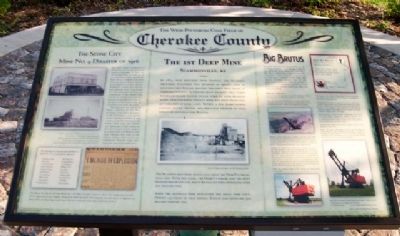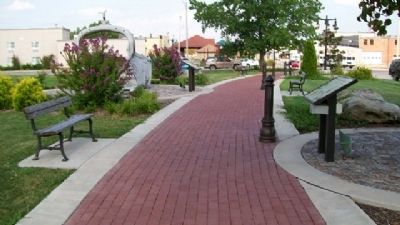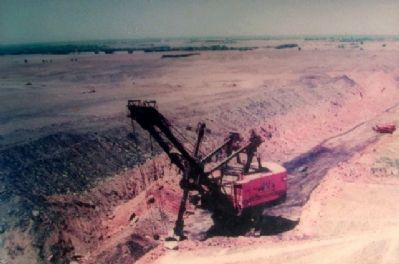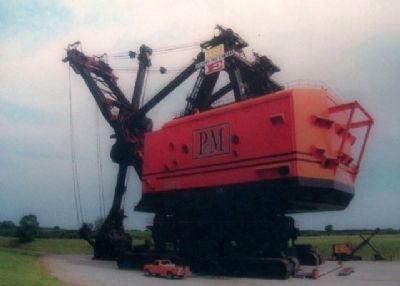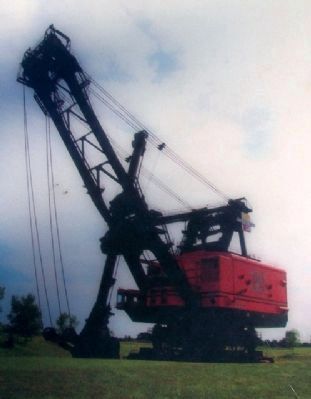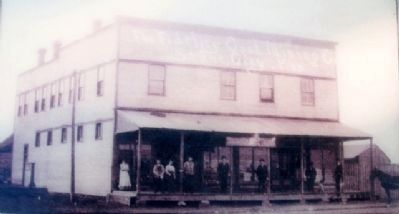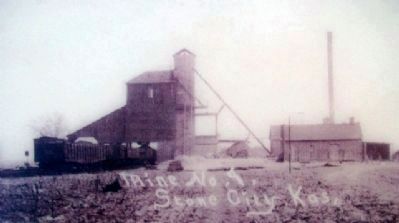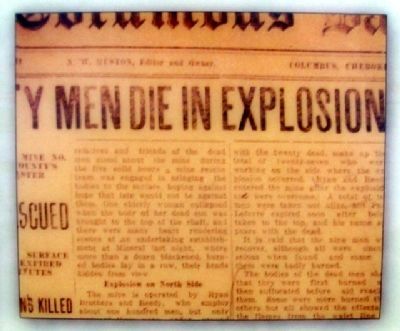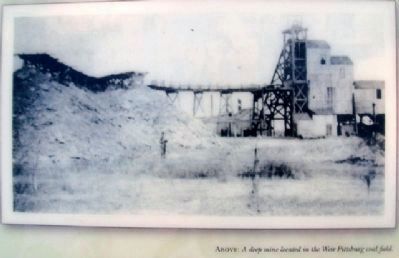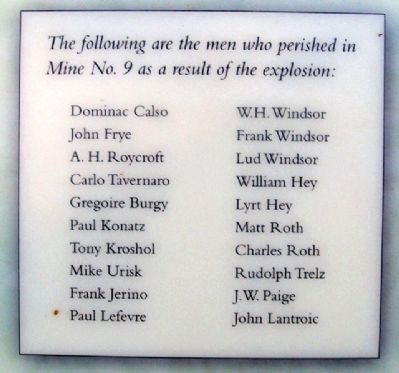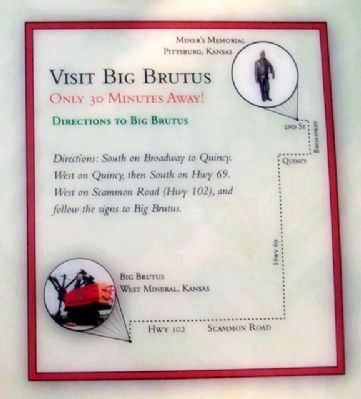Pittsburg in Crawford County, Kansas — The American Midwest (Upper Plains)
The Weir-Pittsburg Coal Field in Cherokee County
— Miners' Memorial at Immigrant Park —
Inscription.
The 1st Deep Mine, Scammonville, KS
In 1874 four brothers from Illinois, the Scammon brothers, pioneered new methods of mining coal in southeastern Kansas, digging the first mine shaft in Cherokee County. Although many doubted that their room-and-pillar system would work in such shallow mines, this Cherokee County mine was soon producing 40 carloads of coal a day. Within a few years, underground mining became the principal method of coal mining in southeastern Kansas.
The Scammon brothers mined coal from the Weir-Pittsburg coal vein. Over the years, the Weir-Pittsburg was the most extensively mined coal bed in Kansas history, producing over 200 million tons.
When the minerals were exhausted the mines were shut. During 150 years of coal mining, Kansas had produced 300 million tons of coal.
The Stone City Mine No. 9 Disaster of 1916
The small mining community of Stone City was rocked the afternoon of December 13, 1916. Due to accumulation of gases in an old entryway at Ryan and Reedy Mine No. 9, a terrible explosion took the lives of twenty men and boys working in the mine that day. Apparently a miner was unknowingly drilling into a gas pocket and upon breaching the wall the combination of his carbide lamp and the gas created the explosion. Although the explosion was major, most of the deaths were due to suffocation after the blast.
The explosion was one of the worst accidents in the Weir-Pittsburg Coal Field. According to the December 15, 1916 edition of the Cherokee Sentinel, “It was a pitiful sight. The families of the miners were upon the ground and whenever a body would be brought up each would think it was their loved one. Women were panic stricken, and some of the foreign women who could not understand English were kept from the shaft with difficulty.
Dominac Calso • W. H. Windsor
John Frye • Frank Windsor
A.H. Roycroft • Lud Windsor
Carlo Tavernaro • William Hey
Gregoire Burgy • Lyrt Hey
Paul Konatz • Matt Roth
Tony Kroshol • Charles Roth
Mike Urisk • Rudolph Trelz
Frank Jerino • J.W. Paige
Paul Lefevre • John Lantroic
According to the book An Outing With the Long-Bell Lumber Company, Stone City mining camp “presents the best appearance of any ‘company’ mining town within the district. The Company owns and rents to its employees 150 houses which are always kept in good repair. The water works and electric light system are the best.”
Big Brutus
Designed and built by Bucyrus-Erie for the Pittsburg & Midway Coal Mining
Company, the 1850-B, one of the world’s two largest shovels, was an engineering accomplishment. Ten years prior to construction, such a project would not have been considered feasible. Today, large capacity excavating machines have not only proven to be feasible, but absolutely essential in order to be in a competitive position to meet the production demands of growing utility and industrial markets.
Brutus Facts:
Height: The shovel was taller than a 16 story office building – 160 feet from the ground to the point sheave at the top of the boom.
Power: The power plant provided 7,000 horsepower under normal operating conditions and 15,000 horsepower under peak loads, which was equivalent to power used by a community of 15,000 people.
Movement of Shovel: Four pairs of crawlers, one at each corner of the base, propelled the machine. Each pair of crawlers or trucks were powered by a 300 horsepower motor. Each crawler tread was 5’6” wide and weighted 2008 lbs. The gear case for each truck held 2,200 gallons of gear oil. The normal propelling speed was .22 miles per hour.
Operating Crew: Big Brutus’ operating crew consisted of only three men. One operator, one oiler, and one groundman. The operator was the person in charge of the operating crew. His job was to do the actual digging. He could swing the house with the foot pedals. The oiler was in charge of operating the oil pumps. He was responsible for monitoring all of the lubrication on the machine. He had to roam all over the shovel to insure that each area was receiving proper lubrication. The groundman’s job was to move the shovel whenever the operator signaled him to do so. He also had to insure that the pit floor was clean and level before moving the machine.
Weight: The working weight of the machine was approximately 11,000,000 lbs.
Revolving Frame: Size: 58 feet x 79 feet 6 inches. The body revolved on a base, supported by a roller circle 45 feet in diameter, consisting of 90 rollers each 16 inches in diameter.
Leveling Jacks: The machine was supported on the four crawler tracks by gigantic hydraulic jacks which automatically maintained the shovel in a level working position as it moved over the uneven pit floor. The hydraulic oil was supplied to all four jacks from a central reservoir which had a capacity of 3,200 gallons. The jack cylinders are 42 inches in diameter and have a stroke of 66 inches.
Erection Information: Period of erection was from June 1962 to May 1963. A peak number of 52 men were employed to erect the shovel. 150 railroad cars were required to ship all of the component parts of the shovel. The shovel was erected at P&M’s Mine 19 near Hallowell, Kansas. Big Brutus cost about $6.5 million.
Operating Period: The shovel ran 24 hours a day for 11 years. It ceased operations in April 1974.
Dipper: The capacity of the dipper was 90 cu. yds. By heaping dirt on the dipper, 150 tons of overburden was handled in one scoop or enough to fill three railroad cars. It took four cables 3.5 [inches] thick, and powered by eight 500-horsepower motors, to lift the bucket. Big Brutus’ job was not to remove coal, only overburden.
Erected 2008 by Miners' Memorial.
Topics. This historical marker is listed in these topic lists: Environment • Industry & Commerce • Settlements & Settlers. A significant historical month for this entry is April 1974.
Location. 37° 24.554′ N, 94° 42.417′ W. Marker is in Pittsburg, Kansas, in Crawford County. Marker is on 2nd Street near Pine Street, on the right when traveling west. Marker is at the Miners' Memorial. Touch for map. Marker is in this post office area: Pittsburg KS 66762, United States of America. Touch for directions.
Other nearby markers. At least 8 other markers are within walking distance of this marker. Wilkinson Coal Company (a few steps from this marker); Frontenac, Kansas (a few steps from this marker); Alexander Howat (a few steps from this marker); Southeast Kansas Coal Mining (within shouting distance of this marker); The Amazon Army (within shouting distance of this marker); The Weir - Pittsburg Coalfield (within shouting distance of this marker); Immigrant Park (about 300 feet away, measured in a direct line); The Freedom Tree (approx. ¼ mile away). Touch for a list and map of all markers in Pittsburg.
Also see . . .
1. Miners' Memorial. (Submitted on September 11, 2010, by William Fischer, Jr. of Scranton, Pennsylvania.)
2. Big Brutus. (Submitted on September 11, 2010, by William Fischer, Jr. of Scranton, Pennsylvania.)
Credits. This page was last revised on December 9, 2021. It was originally submitted on September 11, 2010, by William Fischer, Jr. of Scranton, Pennsylvania. This page has been viewed 2,657 times since then and 92 times this year. Photos: 1, 2, 3, 4, 5, 6, 7, 8, 9, 10, 11. submitted on September 11, 2010, by William Fischer, Jr. of Scranton, Pennsylvania.
